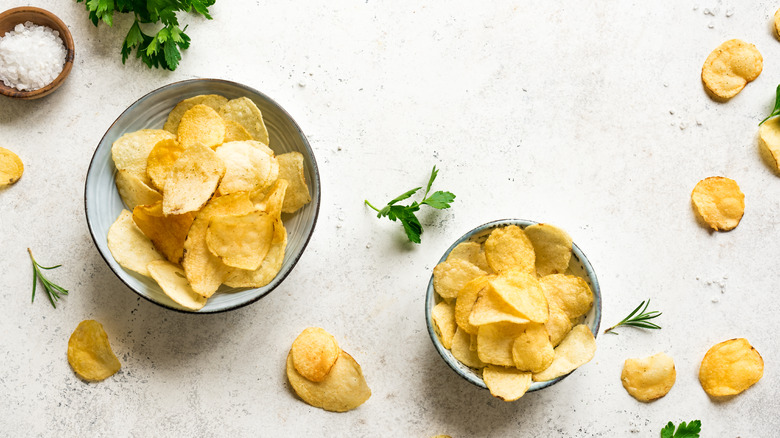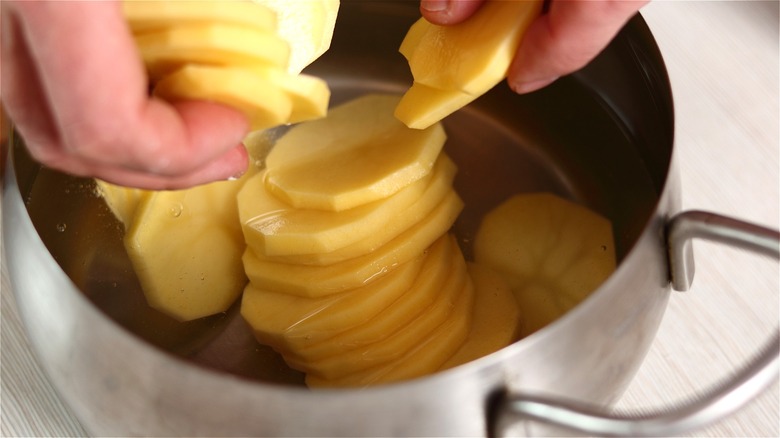The 2 Mistakes You're Making When Frying Homemade Potato Chips
Next to creating a tasty at-home Chex mix, making delectable potato chips right in your home kitchen means achieving the ultimate snack. While you can always buy a bag or two of your favorite thin and crispy potato chips at your nearest grocery store, nothing beats a warm plate of home-fried potato slices. Yet, if you've tried repeatedly to make this crunchy snack and still wind up with lackluster results, you may need to reevaluate some crucial steps in the preparation process.
Since potatoes are filled with sugar and starch, you must be mindful of a few factors to create perfectly crispy potato chips. Even though deep frying potato slices in hot oil seems simple enough, pay extra attention when slicing and soaking. To create evenly cooked potato chips, you may need more than your sharpest knife to get the job done. A mandolin ensures potato slices retain the same size and texture upon cooking. Additionally, instead of relying on pure H20 to slow oxidation and leach out potatoes' extra starches, vinegar may be the secret ingredient that's prevented your homemade potato chips from resulting in not only a lighter color but also maintaining an extra crunchy texture. By utilizing this advice, you'll be enjoying a bowl of crispy golden potato chips in no time.
A mandolin is necessary to create evenly crispy potato chips
A chef's knife has many uses in the kitchen but you may want to relinquish control for a highly accurate kitchen tool when it comes to making homemade potato chips. A mandolin is a sharp blade covered by a smooth flat surface that allows you to slide produce against its edge, creating perfectly uniform cuts. You can buy a basic, no-frills mandolin that comes with only one setting or opt for a mandolin slicer that has the added benefit of adjustable settings and thickness levels depending on the fruit or vegetables you're slicing.
Next to choosing less waxy potatoes like russets, slicing your spuds evenly makes all the difference in regards to both length of cooking time and overall texture. When using a knife, you run the risk of cutting some slices thicker than others which can lead to both raw and overcooked potato chips in the same batch. A mandolin ensures each potato slice has the same thickness. If you have a mandolin with an extra sharp blade and want thinner, crispier chips, slice potatoes at 1/16th of an inch. However, if you like a thicker chip with more of a kettle-like crunch, slice potatoes 1/8 of an inch thick. Not only does a mandolin slicer create even slices but this handy kitchen tool cuts potatoes with speedy efficiency, cutting down on preparation time.
Use vinegar to maintain the structure of sliced potatoes
If you desire potato chips with a quintessential crunch and fair, almost uncooked color, use a bit of vinegar to slow down oxidation or browning and to firm up the exterior of raw potato slices. If you usually soak your precut potatoes in water, adding in a bit of acidity prevents raw tubers from turning an unpleasant shade of brown. If you want blonde potato chips, soak raw slices in plain water first, draining the cloudy water one or two times before doing a final soak with added vinegar. For just the right amount of acidity, use 1/2 cup of vinegar for every 6 cups of water.
Additionally, vinegar could stop your potatoes from softening by keeping your slices extra firm throughout the frying process. Potatoes are naturally high in starch and contain hemicellulose, which is a carbohydrate that can't readily break down in an acidic environment. The addition of vinegar in water as a pre-soak strengthens the natural pectin in potatoes' exterior surface, which leads to even crunchier potato chips. This small amount of acid maintains the overall structure of your sliced potatoes, sidestepping the possibility of mushy or broken snacks. Before you attempt to perfect another batch of homemade potato chips, make sure you have a sharp mandolin and white vinegar at the ready.


